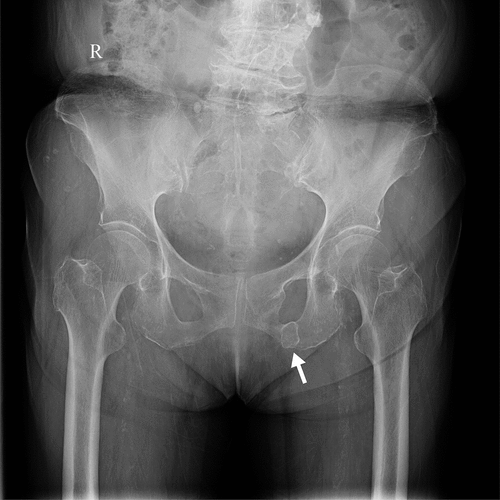Osteochondrosis of the ischiopubic synchondrosis (IPS), also known as Van Neck–Odelberg disease, is a condition characterized by inflammation and degeneration of the IPS, a cartilaginous joint located between the ischium and pubic bones in the pelvis (Citation1). Typically, IPS manifests in young individuals participating in sports involving repetitive running, jumping, or kicking. This case report presents a rare occurrence of IPS in an elderly female patient, highlighting the need to consider this condition in the differential diagnosis of persistent pain and tenderness in the ischial tuberosity region in older individuals.
An 88-year-old female patient came to our orthopaedic department reporting enduring pain and tenderness in her left buttock for the past 3 months. The patient denied any history of injury in the area. Physical examination revealed tenderness localized to the left ischial tuberosity, without any other significant findings. X-ray imaging of the pelvis confirmed the diagnosis of Van Neck–Odelberg disease, displaying characteristic changes in the ischial tuberosity (indicated by the arrow in ).
Figure 1. X-ray imaging of the pelvis confirmed the diagnosis of Van Neck–Odelberg disease, displaying characteristic changes in the ischial tuberosity (arrow).

Following the diagnosis, the patient was advised to avoid strenuous activities that could exacerbate her symptoms. Non-steroidal anti-inflammatory drugs (NSAIDs) were prescribed to alleviate pain and reduce inflammation. Physical therapy was initiated to improve hip joint mobility and strengthen the pelvic muscles. The physical therapy programme included targeted exercises focusing on range of motion, stretching, and strengthening of the affected area, tailored to the patient’s specific needs and limitations.
At the 2 month follow-up appointment, the patient reported a notable decrease in pain and an enhancement in overall function. The combined approach of activity modification, NSAID use, and physical therapy played a crucial role in alleviating the patient’s discomfort and enhancing her quality of life. The patient’s adherence to activity modifications and personalized physical therapy exercises contributed to the positive outcomes observed.
Van Neck–Odelberg disease is a condition predominantly observed in adolescent athletes, with a higher prevalence in males (Citation2). The case described here is an unusual manifestation of IPS in an elderly female patient. The reasons underlying the late-onset presentation of IPS in this patient remain unclear. However, this case report highlights the importance of considering IPS as a potential diagnosis, even in elderly female patients presenting with persistent pain and tenderness in the ischial tuberosity region. Thorough evaluation, accurate diagnosis, and appropriate management are crucial in providing effective care for musculoskeletal complaints in the elderly population.
Disclosure statement
No potential conflict of interest was reported by the authors.
References
- Pirimoglu B, Sade R. An unusual cause of groin pain in a child: van Neck-Odelberg disease. Joint Bone Spine 2019;86:257.
- Sabir N, Çakmak P, Yılmaz N, Yüksel S. Osteochondrosis of ischiopubic synchondrosis: Van Neck–Odelberg disease. J Pediatr 2021;229:307–8.

